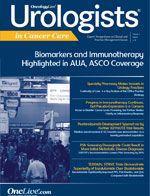Publication
Article
Oncology Live Urologists in Cancer Care®
Amnion/Chorion Wrap Improves Outcomes Following Robot-Assisted Prostatectomy
Author(s):
Using an allograft made up of dehydrated human amnion/chorion membrane wrapped around the neurovascular bundle (NVB) during nerve-sparing robot-assisted radical prostatectomy improved continence and potency postsurgery, according to results of a small study.
Vipul R. Patel, MD
Using an allograft made up of dehydrated human amnion/chorion membrane (dHACM) wrapped around the neurovascular bundle (NVB) during nerve-sparing robot-assisted radical prostatectomy (RARP) improved continence and potency postsurgery, according to results of a small study conducted by Vipul R. Patel, MD, professor of urology, University of Central Florida College of Medicine and medical director, Global Robotics Institute at Florida Hospital Celebration Health. Findings were published online in European Urology.
“The use of dHACM in the wound care field led urologists to consider using these grafts in patients undergoing PARP,” said Patel.
Although PARP has many advantages, including enhanced magnification, 3D vision, and the dexterity of miniaturized instrumentation, the recovery period is characterized by incontinence and impotence, most likely the result of the inflammatory response caused by traction injury to the NVB.
Researchers analyzed postoperative outcomes in 58 men who were preoperatively potent and continent and who had undergone full nerve-sparing PARP. Overall, 58 patients had dHACM placed over each NVB as a nerve wrap after extirpative RARP. These patients were computer-matched with a similar group of 58 men who did not receive a dHACM allograft.
A single surgeon performed all the RARP procedures using the transperitoneal six-port technique with a Da Vinci surgical system. Bilateral, retrograde, athermal nerve-sparing RARP was performed in each patient, with bladder neck reconstruction, an anterior suspension stitch, and posterior reconstruction.
The wrap was placed around the NVB after extirpative RARP, post anastomosis. The dHACM study cohort (group 1; n = 58) was computer-matched with a similar group of patients who did not receive a dHACM graft (group 2; n = 58) in a multivariate design to create homogeneous groups.
All patients in both groups completed an eight-week follow up period, with an average follow-up of four months. The researchers report that continence returned at eight weeks in 81.0% of patients in group 1 and 74.1% of patients in group 2 (P = .373).
The mean time to achieve continence was shorter in group 1 (1.21 months) than in group 2 (1.83 months; P = .033). During the same period, potency returned in 65.5% of patients in group 1 and 51.7% of patients in group 2. The mean time to potency was significantly shorter in group 1 (1.34 months) than in group 2 (3.39 months; P = .007). The analysis also showed higher scores on the Sexual Health Inventory for Men questionnaire in the allograft cohort than in the non-allograft cohort. No adverse effects related to dHACM placement were reported.
The results suggest that the use of dHACM facilitates early return to continence and potency. The mean times to potency and continence were significantly shorter in the allograft group. Other uses of dHACM include the treatment of wounds, burns, corneal injuries, chronic venous ulcers, and chronic wounds.
“The use of tissue allografts such as AmnioFix in urology is an evolving field,” said Patel. An adequately powered prospective randomized trial and cost-benefit analysis of dHACM around the prostatic NVB are now under way to further ascertain the treatment effect of this new approach. The researchers concluded that their short-term results are encouraging for patients undergoing full nerve-sparing RARP and dHACM placement.
Patel VR, Samavedi S, Bates AS, et al. Dehydrated human amniotic membrane allograft nerve wrap around the prostatic neurovascular bundle accelerates early return to continence and potency following robot-assisted radical prostatectomy: propensity score—matched analysis. Eur Urol. 2015;67(6):977-980.










